How to Travel With a Gun: Ultimate Guide

Whether you’re planning a quick road trip out of state or you’re thinking about traveling overseas, you’re likely wondering whether you’ll be able to bring your trusty side piece along.
The question of how to travel with a gun is a complicated one to answer, as there are so many variables to consider. As a general rule, traveling within the U.S. is usually a pretty simple process while traveling between countries is more difficult.
In this article, we’ll cover everything from traveling with a firearm while flying, to driving, to taking a cruise, and discuss the precautions you’ll have to take both within the United States and abroad.
Products Mentioned In This Article
Traveling in the U.S. With a Gun
While state laws do certainly vary, the United States has some of the most permissive firearms laws on the planet. That is to say, it is generally easier for average citizens to own and carry guns for self-defense within the U.S. than it is for people just about anywhere else.
But, because state laws vary so much, it’s vitally important that you know and follow your state and local laws: the information here is intended to be general, and is in no way legal advice.
Driving In State
Aside from walking, driving within a single state is the simplest way to travel with a firearm in the United States. If you have a concealed carry permit, your state will almost certainly allow you to conceal a weapon on your person while driving.
Here, the complications come mostly from two things. First is when you must go to a place where concealed carry is illegal, such as a post office (which is federal property, meaning you cannot have a firearm on-site). In cases like that, follow state laws about safe storage. Generally, putting your carry gun in the glove box, locking that, and then locking the car would be sufficient, and a small safe would be even better.
Second, folks without concealed carry permits will likely have to jump through additional hoops, such as placing the gun, unloaded, in a case the driver of the vehicle cannot access it.
If your state offers concealed carry permits, getting one is typically going to make it so that you can easily drive or be a passenger in a car while carrying a firearm.
For more details about driving with and leaving a gun in a vehicle, check out our Guide to Car Concealed Carry.
Public Transit In State
If you’re using more eco-friendly or gas-money-saving forms of transportation like local trains and buses, then the first thing to do here is to find the published policies of whatever government agency runs the transportation you plan to use.
Beyond that, there is not much specific guidance that I can give because state and local laws vary so widely. For instance, some states have, either by law or state constitution, made it impossible for cities, counties, or townships to make laws that contradict state regulations on things like firearms possession.

Other places have no such laws, meaning that it is entirely possible to be legally concealed carrying at a bus stop in one town, and you’d be committing a major crime when you stepped off of the same bus, 10 minutes later, in the next town over.
So, doing your homework is key here. Check with both your state and municipal laws to ensure you’re doing things by the book, and verify that you’re following the policies of any privately-owned transportation service like a rideshare or cab company.
Driving Between States
Once again, every state has different laws regarding concealed carry, so if you plan to drive through more than one of them you’ll need to brush up on the regulations in each.
One thing to be aware of when you are driving between states is that you have to comply not only with the laws of the states you are stopping in, but also those of every state you drive through.
Say, for example, you lived in the Florida panhandle and planned a road trip to New Orleans, Louisiana. Even though you might not even need to stop for gas in Alabama or Mississippi, you would need to comply with the laws of every state you drive through.
One more thing that can vary: some states require people with firearms to tell officers about them at traffic stops, while others do not. Again, doing some research before you leave can inform you as to what to do if you get pulled over.
As someone who has driven while carrying a firearm in several states, I also personally recommend that you do not speed: the best way to avoid having to deal with local law enforcement, especially when you have an out-of-state license plate, is to not stand out from traffic in the least.
Vedder Holsters has put together a really useful tool that can help you determine whether your CCW permit is recognized by the states you plan to travel through, as well as break down the local laws in each. We strongly recommend taking a look at this before hitting the road!
Trains Between States
In doing research for this piece, I assumed that train travel between states would work similarly to either driving or using local public transportation. It turns out, I was incorrect!
Amtrak has a fairly lengthy page of procedures and requirements to check a firearm on a train. Importantly, you cannot conceal or carry a firearm on an Amtrak train between or within states, and you’ll need to call ahead to arrange the checking-in of a firearm.
Of course, in addition to the rules of the train itself, you’ll have to think about the laws in your departure location, arrival location, and all jurisdictions in between. Since a train could have to make an unscheduled stop, you should make sure that any guns you take on a train are legal to own in every jurisdiction that you travel through. That makes traveling with weapons on a train something more akin to traveling with firearms in a car but with the addition of Amtrak regulations.
Domestic Flights
Flying domestically with a gun is possible, but, like traveling by train, you will not be permitted to carry on a plane. But, you can check a firearm in your luggage so long as you follow the proper procedures.
The Transportation Security Administration (TSA), publishes all of its requirements for flying with a gun online. Generally, the firearm has to be unloaded, in a locked case, and with any ammunition stored separately from your weapon. Folks who do this regularly often recommend simply keeping the ammunition in the factory box to make things as simple as possible for the gate agent.

In addition to TSA policies, you’ll have to abide by the airline’s policies as well. This generally includes specific instructions for declaring the firearm at the check-in counter as well as for picking your weapon back up once you reach your destination.
It’s also highly recommended to show up an extra hour early if you plan to check a firearm: some airline personnel are neither knowledgeable nor especially cooperative about this, so it might take a little while to get checked in, and you don’t want to miss your flight.
Finally, you’ll have to, as usual, make sure that you’re following the laws of the states you are leaving from and traveling to. If you’re planning to book a flight in the near future, check out our ultimate guide to How to Fly With a Handgun.
International Travel with Guns
Now that we’ve covered traveling within the United States with a firearm, that brings us to the next question: can you travel with a gun overseas?
Technically, yes, you can travel internationally with a gun under certain very limited circumstances. But, with that said, those circumstances are so limited, and the consequences for breaking the firearms laws in other places are so steep, that most people choose not to risk it. Let’s take a look at some more common ways to travel abroad.
Cruise Ships
Cruise ships are an interesting one legally speaking. Since they’re registered in one country, those laws generally apply while the ship is in international waters. That’s why, for example, a cruise ship’s drinking age might be 21 while in U.S. territorial waters, and then the captain announces a drinking age of 18 once out to sea a sufficient distance.

Aside from the international laws at play on the decks of the ship itself, you’ll have to follow the laws of the nations in which the cruise stops. Mexico, for example, generally does not allow for civilian firearms ownership, and this is doubly true of people who are not Mexican nationals. The same goes for most of the Caribbean.
To avert all of this trouble, most cruise lines simply forbid passengers from bringing firearms of any kind onboard unless it's in the hands of professional security personnel that have been hired by the cruise line. For instance, Royal Caribbean doesn’t allow weapons of any kind on their vessels.
Crossing Borders By Car
When it comes to driving across the border into another country, things get a little tricky. If you plan to cross the border into Mexico or Canada, it’s critical that you know the laws and obtain any necessary permits ahead of time to avoid serious legal repercussions.
For example, the land border between the U.S. and Canada is one of the longest on the planet, and the two countries are considered some of the closest allies in international relations. But, that coziness does not extend to firearms laws.
It is technically possible to take a gun into Canada, but not exactly a clear and transparent process. According to The Canada Border Services Agency, you must have a valid reason for bringing weapons into Canada, which they will verify at the border.
Generally, it might be possible for an American (or Canadian) citizen to bring a firearm into Canada if said firearm is legal to own in Canada (which is a much, much shorter list than what is legal in the US), the person has (or applies for) a Canadian firearms license, and the border agent is sufficiently satisfied that you have a legitimate purpose for that gun in Canada.
All-in-all, it might be much less risky if, for instance, you simply borrowed a rifle from your guide if you plan to hunt in Canada. Experienced hunting outfitters will likely have much more specific advice, and if you plan to take a gun into Canada, that’s who I would ask first.
Likewise, if you plan to transport firearms into Mexico, you must receive prior written authorization from the Mexican government. You will need to verify that the gun is legal in Mexico and receive a temporary import permit from the Secretariat of National Defense. Failure to do so could result in some serious consequences, including up to five years in prison.
International Flights
The rules for flying with a firearm internationally are largely the same as within the U.S. But checking a gun on a plane is the easy part – the issues begin when you land in another country.

Let’s say you’re flying to the United Kingdom, for example. The UK government is extremely clear on the matter: unless you are importing firearms to sell to, or on behalf of, the government or a film production, you cannot legally import a firearm into the country. And doing so could land you in prison for life.
So, if you’re planning a trip overseas and want to bring your gun, check with the laws in that country first. You’ll likely find that most countries aren’t too fond of people bringing firearms over the border, whether for self-defense purposes or not.
Summary
If you’re planning a trip, you likely have plenty of questions about how to travel with a gun, and whether it’s legal in the first place.
It is generally legal to travel domestically, and sometimes to select international countries, with a firearm assuming you’re willing to jump through some hoops. With that said, the most important thing to remember is to do your legal research ahead of time, and, when in doubt, check with an expert.
If you’re looking for a new IWB, OWB, or pocket carry holster, head to our Holsters by Gun Model page for Kydex holsters that are custom-made for your weapon of choice.
Interested in items beyond holsters? Take a look at our Resources Page for links to recommended products like lights, lasers, first aid, maintenance, and more. Or, browse our selection of apparel, gun belts, and accessories. And be sure to visit our sister company, GeoGrit, to view our collection of durable, RFID-blocking minimalist wallets.
To stay up-to-date on all the latest Vedder Holsters content and offerings, follow us on Facebook, Instagram, Twitter, YouTube, and TikTok. For more shooting and concealed carry resources, check out our blog or download our FREE e-book “The Concealed Carry Blueprint.” To discover which states honor your carry permit or to learn about CCW laws across the U.S., explore our interactive Reciprocity Map.



